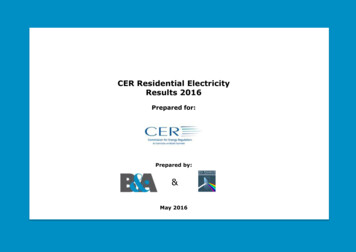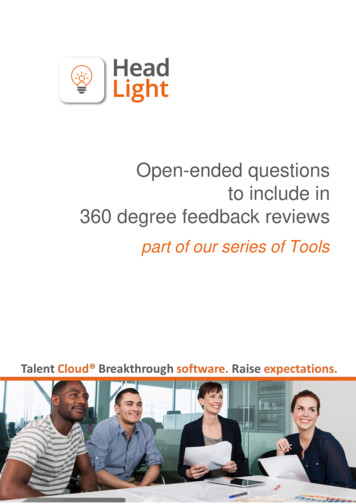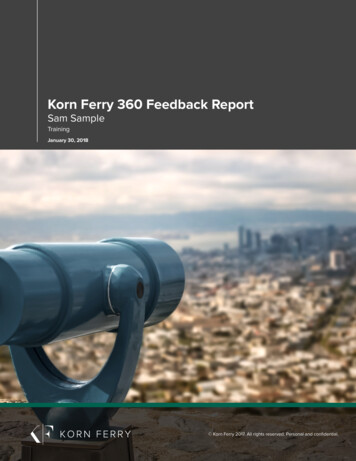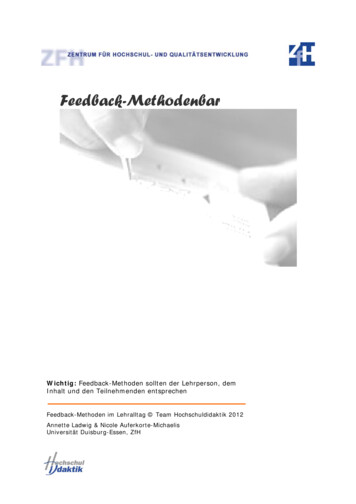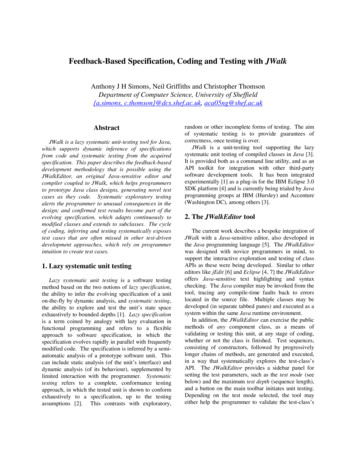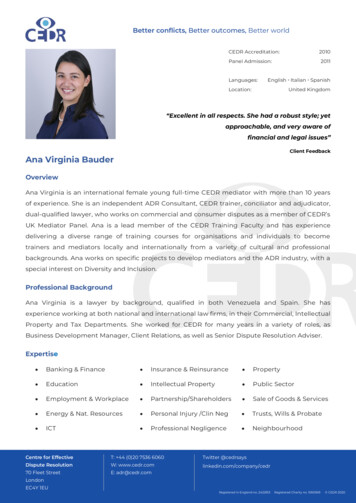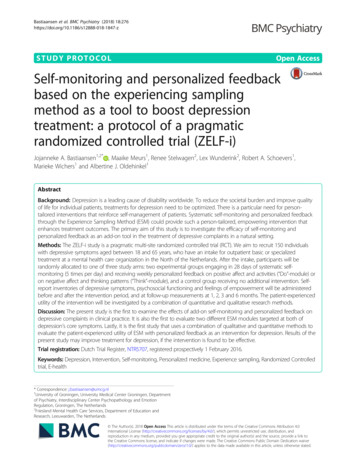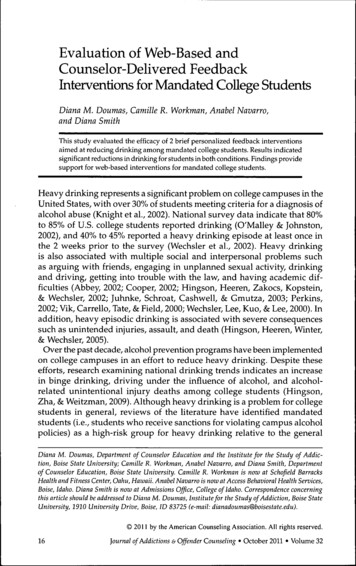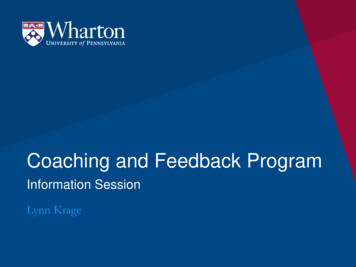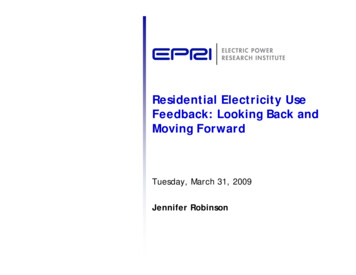
Transcription
Residential Electricity UseFeedback: Looking Back andMoving ForwardTuesday, March 31, 2009Jennifer Robinson
Today’s Presentation Definitions and context Feedback delivery mechanisms Past research:– Results and gaps Ongoing research:– Addressing the gaps, preliminary results Going forward 2009 Electric Power Research Institute, Inc. All rights reserved.2
Feedback Defined What is feedback:– “A process whereby the results of action servecontinually to modify further action.”-- Webster’s Pocket Dictionary, 1997– Household-specific electricity consumptioninformation 2009 Electric Power Research Institute, Inc. All rights reserved.3
Context Why consider feedback, why now?– Pressing issues support the need for conservation andefficiency Climate change New power generation requirements Transmission constraints– New technologies allow for ease of provision– Conservation results So why isn’t everyone doing it?– EPRI wants to help understand and resolveutility/regulator/customer concerns 2009 Electric Power Research Institute, Inc. All rights reserved.4
Feedback Real-timePlusMonthly or bimonthly billHouseholdspecific infoand advice,comparisonsWeb-basedenergy audits billing analysis,est. appliancedisaggregationFrom actualusage data, mail,email, self-read,day-lag webbased, etc.“Indirect” Feedback(provided after consumption occurs)Energy displaydevices, pricingdisplay devicesReal-time,appliance levelmonitoring orcontrol, HAN“Direct” Feedback(provided real-time)Information availabilityHighLowCost/effort to implement 2009 Electric Power Research Institute, Inc. All rights reserved.5
Feedback Body of Research – Past Several critical summary analyses:– Darby 2001, 2006– Fischer, 2007– Abrahamse, et al., 2005 Average conservation effects:– Direct feedback: 5-15% range– Indirect feedback: up to 10% From EPRI, 2009 report:– 31 past studies: wide range, from -5.5% to 18% 2009 Electric Power Research Institute, Inc. All rights reserved.6
A Range of ResultsAverage Conservation Effects20%Percent Savings15%10%5%0%-5%-10%Type 2 2009 Electric Power Research Institute, Inc. All rights reserved.3Type 4Type 57Type 6
A Range of ResultsScandinavian studies (early 80s to late 90s)- Enhanced billing- N 611-2,000- t up to 3 yearsAverage Conservation Effects- 8-10% savings- Main factor was increased frequency and20%accuracy’- Effects were found to persistPercent Savings15%10%5%0%-5%-10%Type 2 2009 Electric Power Research Institute, Inc. All rights reserved.3Type 4Type 58Type 6
A Range of ResultsBritish Columbia, Ontario, Newfoundland (2005, 2007)- Same energy display deviceAverage Conservation Effects- N 43, 382, 58- T 18, 12, 18 months20%- 2.7%, 6.5%, 18%- Time trend in model indicated persistence of effectsPercent Savings15%10%5%0%-5%-10%Type 2 2009 Electric Power Research Institute, Inc. All rights reserved.3Type 4Type 59Type 6
Feedback Body of Research – Past Research gaps:– Feedback delivery mechanism/type– Participation levels– Persistence– Pricing interactions– Demographic distributions1StandardBilling(e.g. monthly,bi-monthly)2EnhancedBilling(e.g. info andadvice,householdspecific orotherwise)34EstimatedFeedback(e.g. web-basedenergy audits billing analysis,est. appliancedisaggregation)Daily/WeeklyFeedback(e.g. based onconsumptionmeasurements,by mail, email,self-meterreading, etc.)“Indirect” Feedback(provided after consumption occurs)5Real-timeFeedback(e.g. in-homedisplays, pricingsignal capability)6Real-timePlus(e.g. HANs,appliancedisaggregationand/or control)“Direct” Feedback(provided real-time)Information availabilityLowHighCost to implement 2009 Electric Power Research Institute, Inc. All rights reserved.10
Area 1: Feedback Delivery backReal-timePlusMonthly or bimonthly billHouseholdspecific infoand advice,comparisonsWeb-basedenergy audits billing analysis,est. appliancedisaggregationFrom actualusage data, mail,email, self-read,day-lag webbased, etc.“Indirect” Feedback(provided after consumption occurs)Energy displaydevices, pricingdisplay devicesReal-time,appliance levelmonitoring orcontrol, HAN“Direct” Feedback(provided real-time)Information availabilityHighLowCost/effort to implement 2009 Electric Power Research Institute, Inc. All rights reserved.11
Area 2: Participation Levels Treatment group participation levels vary substantially Most were less than 20020%Conservation Effect15%10%EuropeJapan5%North America0%050010001500-5%-10%Participation Levels 2009 Electric Power Research Institute, Inc. All rights reserved.1220002500
Area 3: Persistence of Effects Some evidence of persistence Mainly involving enhanced billing (type 2) and displaydevices (type 5) Generalizability of the findings to the NA situation? Appropriate study length? 2009 Electric Power Research Institute, Inc. All rights reserved.13
Area 4: Feedback and Pricing How do the two interact, if at all? Relatively new )Feedback Effect(Overall Conservation)Feedback Effect(On-Peak Reduction)2CASPPCASPPElliott, et al. , 2006315240%0%Robinson 2007410630%0%Hydro One 2008541154%Incremental effect of 1.8% overTOU ratesMartinez and Geltz 20055612NA0%Sexton, et al., 198755110-5.5% (increase)Incremental effect of 1.2% overTOU rates6 2009 Electric Power Research Institute, Inc. All rights reserved.14
Area 5: Demographic EffectsTraitEvidence From StudiesAgeGreater effect with younger households?IncomeVariation in findingsEducationGreater effect with more highly educated households?ElectricityconsumptionGreater effect with higher consumers? Some potential variations, but the links are tenuous 2009 Electric Power Research Institute, Inc. All rights reserved.15
Feedback Body of Research – Ongoing Ongoing pilot activity– Mostly display devices (type 5)14 Ongoing Utility PilotsBaltimore Gas & ElectricNV EnergyDominion Virginia PowerOFGEM (UK)Duke EnergyOmaha Public Power DistrictEnergy Trust of OregonSaskPowerFocus on Energy WisconsinSacramento Municipal Utility District (SMUD)Hydro OneTXUNational Grid, NSTAR, W. Mass ElectricWe Energies 2009 Electric Power Research Institute, Inc. All rights reserved.16
Ongoing: Baltimore Gas & Electric Feedback type: 5 Pricing display device assessment as part of dynamic pricingand enabling technology pilot N 625 (subset of 1,300 home pilot) Duration: Feb ‘08 – Mar ‘09 Results (preliminary, November 2008):– 6-7% peak reduction attributable to pricing display device– Continuing on this summer, using energy display device aswell as pricing display device– Commercial 2009 Electric Power Research Institute, Inc. All rights reserved.17
Ongoing: SMUD Feedback types: 2, 5 Monthly/quarterly energy reports (type 2); ongoingdisplay device program (type 5) N 35,000 (type 2); 10,000 (type 5, billingassessment will involve fewer) Duration: 4 years (type 2); 1 year (type 5) Results (preliminary, November 2008):– Type 2: after 6 months, a 2% savings comparedto control We Energies: embarking on similar feedbackassessments 2009 Electric Power Research Institute, Inc. All rights reserved.18
Ongoing: Energy Demand Reduction Pilot (UK) Feedback types: 2, 5 Wide range of information and feedback provision mediabeing assessed N tens of thousands Duration: at least two winters and two summers;completed by February 2009 Results (preliminary, June 2008):– No statistical sig. effect for billing and display devicetrials– Various surveys: up to half of display device recipientsnot using device; half of these because the battery wasnot changed when required– One survey: a high % of people who installed theirdevice changed their habits 2009 Electric Power Research Institute, Inc. All rights reserved.19
Feedback Body of Research – Ongoing Feedback type: two large programs (OFGEM and SMUD)are comparing different types of feedback deliverymechanisms (type 2 and type 5) Participation levels: about half have sample sizes over500 Persistence: almost all studies are now at least one yearin length to assess persistence Fewer pilots are looking at pricing and feedbackinteraction effects Fewer will be able to assess demographic variations ofany potential feedback effects 2009 Electric Power Research Institute, Inc. All rights reserved.20
Moving Forward - Collaborative Research Research gaps act as barriers to making decisions aboutwhat type of feedback and associated delivery systemsare cost effective Requires research of scope and scale that is beyond themeans of any one utility A collaborative organized effort:– avoid redundancy– focusing research on high-value issues– leverage pool of research talents– provide extensible results 2009 Electric Power Research Institute, Inc. All rights reserved.21
Moving Forward - Feedback EM&V Behavior-dependent effect: problematic in includingfeedback in energy efficiency portfolios Standardized method to include feedback in EM&V? 2009 Electric Power Research Institute, Inc. All rights reserved.22
Moving Forward - Feedback EM&V Behavior-dependent effect: problematic in includingfeedback in energy efficiency portfolios Standardized method to include feedback in timePlusMonthly or bimonthly billHouseholdspecific infoand advice,comparisonsWeb-basedenergy audits billing analysis,est. appliancedisaggregationFrom actualusage data, mail,email, self-read,day-lag webbased, etc.“Indirect” Feedback(provided after consumption occurs) 2009 Electric Power Research Institute, Inc. All rights reserved.23Energy displaydevices, pricingdisplay devicesReal-time,appliance levelmonitoring orcontrol, HAN“Direct” Feedback(provided real-time)
Moving Forward - Feedback EM&V Behavior-dependent effect: problematic in includingfeedback in energy efficiency portfolios Standardized method to include feedback in timePlusMonthly or bimonthly billHouseholdspecific infoand advice,comparisonsWeb-basedenergy audits billing analysis,est. appliancedisaggregationFrom actualusage data, mail,email, self-read,day-lag webbased, etc.“Indirect” Feedback(provided after consumption occurs) 2009 Electric Power Research Institute, Inc. All rights reserved.24Energy displaydevices, pricingdisplay devicesReal-time,appliance levelmonitoring orcontrol, HAN“Direct” Feedback(provided real-time)
Moving Forward - Feedback EM&V Behavior-dependent effect: problematic in includingfeedback in energy efficiency portfolios Standardized method to include feedback in timePlusMonthly or bimonthly billHouseholdspecific infoand advice,comparisonsWeb-basedenergy audits billing analysis,est. appliancedisaggregationFrom actualusage data, mail,email, self-read,day-lag webbased, etc.“Indirect” Feedback(provided after consumption occurs)5Real-timeFeedbackEnergy displaydevices, pricingdisplay devices 2009 Electric Power Research Institute, Inc. All rights reserved.25Energy displaydevices, pricingdisplay devicesReal-time,appliance levelmonitoring orcontrol, HAN“Direct” Feedback(provided real-time)
Moving Forward - Feedback EM&V Behavior-dependent effect: problematic in includingfeedback in energy efficiency portfolios Standardized method to include feedback in timePlusMonthly or bimonthly billHouseholdspecific infoand advice,comparisonsWeb-basedenergy audits billing analysis,est. appliancedisaggregationFrom actualusage data, mail,email, self-read,day-lag webbased, etc.Energy displaydevices, pricingdisplay devicesReal-time,appliance levelmonitoring orcontrol, HAN“Direct” Feedback(provided real-time)“Indirect” Feedback(provided after consumption occurs)TOU?5YReal-timeFeedbackNPrepaid?Energy displaydevices, pricingdisplay devicesYNDisplay TypeEnergy 2009 Electric Power Research Institute, Inc. All rights reserved.Price26Other
Moving Forward - Feedback EM&V Behavior-dependent effect: problematic in includingfeedback in energy efficiency portfolios Standardized method to include feedback in timePlusMonthly or bimonthly billHouseholdspecific infoand advice,comparisonsWeb-basedenergy audits billing analysis,est. appliancedisaggregationFrom actualusage data, mail,email, self-read,day-lag webbased, etc.Energy displaydevices, pricingdisplay devicesReal-time,appliance levelmonitoring orcontrol, HAN“Direct” Feedback(provided real-time)“Indirect” Feedback(provided after consumption occurs)TOU?5YReal-timeFeedbackNPrepaid?Energy displaydevices, pricingdisplay devicesYNDisplay TypeEnergy 2009 Electric Power Research Institute, Inc. All rights reserved.Price27Other
Moving Forward - Feedback EM&V Behavior-dependent effect: problematic in includingfeedback in energy efficiency portfolios Standardized method to include feedback in timePlusMonthly or bimonthly billHouseholdspecific infoand advice,comparisonsWeb-basedenergy audits billing analysis,est. appliancedisaggregationFrom actualusage data, mail,email, self-read,day-lag webbased, etc.Energy displaydevices, pricingdisplay devicesReal-time,appliance levelmonitoring orcontrol, HAN“Direct” Feedback(provided real-time)“Indirect” Feedback(provided after consumption occurs)TOU?5YReal-timeFeedbackNPossible RangePrepaid?Energy displaydevices, pricingdisplay devicesYX%NDisplay TypeEnergy 2009 Electric Power Research Institute, Inc. All rights reserved.Price28OtherY%
Thank YouTogether Shaping the Future of ElectricityWe welcome comments and suggestions:Jennifer Robinson865-218-8068jrobinson@epri.comEPRI (2009). Residential Electricity Use Feedback: A ResearchSynthesis and Economic Framework. EPRI, Palo Alto, CA: roduct id 000000000001016844 2009 Electric Power Research Institute, Inc. All rights reserved.29
ReferencesAbrahamse, W., L. Steg, C. Vlek, and T. Rothengatter (2005). “AReview of Intervention Studies Aimed at Household EnergyConservation.” Journal of Environmental Psychology, 25(3): 273–291.Darby, S. (2006). “The Effectiveness of Feedback on EnergyConsumption: A Review for DEFRA of the Literature on Metering,Billing and Direct Displays.” Environmental Change Institute,University of Oxford. Oxford, UK. Retrieved July 2008, pdfEPRI (2009). Residential Electricity Use Feedback: A ResearchSynthesis and Economic Framework. EPRI, Palo Alto, CA: roduct id 000000000001016844Fischer, C. (2007). Influencing Electricity Consumption via ConsumerFeedback: A Review of Experience. Proceedings of the EuropeanCouncil for an Energy Efficient Economy (ECEEE) 2007 SummerStudy, Panel 9 Dynamics of Consumption: 1873–1884. 2009 Electric Power Research Institute, Inc. All rights reserved.30
Residential Electricity Use Feedback: Looking Back and Moving Forward Tuesday, March 31, 2009 . Hydro One TXU Focus on Energy Wisconsin Sacramento Municipal Utility District (SMUD) . Prepaid? Y N TOU? Y N Real-time Feedb

